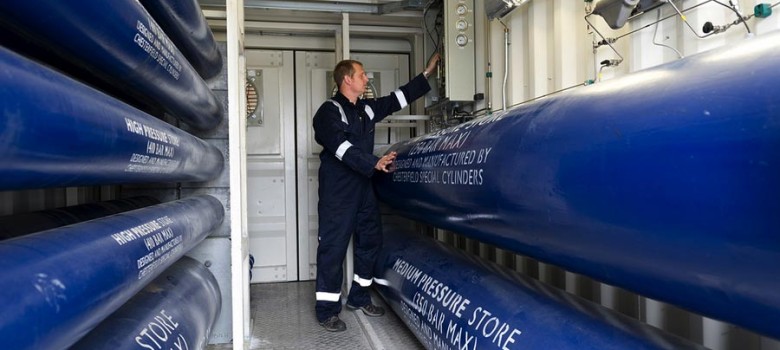
What is hydrogen?
Hydrogen is the most abundant element in the universe but naturally occurring hydrogen on earth is rare. This is because it is highly reactive, and so it reacts with most elements to form compounds that we see around us today. Hydrogen is found in pretty much all the food we eat, in fossil fuels to power our cars and also in water, which is made up of two hydrogen atoms combined with one oxygen atom.
If hydrogen is isolated and ignited with a flame in air, it will combust fiercely and produce heat and water as a by-product. There are already cars that run solely on hydrogen, which means that these cars are 100% emission free. So hydrogen is abundant and combusts with zero dangerous emissions, which makes it a perfect candidate for energy storage.
How can hydrogen combat volatilities in electricity demand?
Many countries have electricity demand volatilities, where a large amount of electricity is needed at rush hour, and again when people come home and use appliances during the evening. Conversely, while people are asleep at night, demand is much lower. This is a rather simplistic model, but it demonstrates the electricity demands of the modern world.
Unfortunately electricity cannot be stored, and at the moment most is either used or wasted as it is produced. However, if we intervene correctly we can transfer the excess electricity into another form of potential energy such as hydrogen. It can then be used to create electricity when required, thereby reducing the volatility of demand on the grid.
Producing hydrogen for grid storage
The main commercial process used for creating pure hydrogen is steam reforming, which involves breaking down a hydrocarbon into hydrogen and carbon monoxide.
However, as an energy storage measure for the grid, the most suitable method of creating hydrogen is through a process called electrolysis, which is simply using electricity and water. Importantly, hydrogen can be produced using electricity sourced from renewable sources such as wind and solar. Therefore when there is excess supply capacity, such as during the night when demand is also low, this excess electricity can be used to produce the hydrogen.
The process of the electrolysis of water involves passing an electrical current through water, which then produces pure hydrogen gas and oxygen. Two electrodes are positioned in the water, and when an electrical current is passed down the cathode (the negatively charged electrode) hydrogen bubbles out, while at the anode (the positively charged electrode) oxygen is released.
Another potential mechanism for making hydrogen is using algae or cyanobacteria, which use the sun to split water into hydrogen and oxygen. Under normal conditions, however, hydrogen production is secondary to the production of compounds that the organisms use to support their growth. However specialised enzymes can be introduced to suppress sugar production in the organism so it produces much more hydrogen gas. This research is still at an early stage, but the paper that describes the process can be found here.
What do we do with the hydrogen sas produced?
This hydrogen gas can then be stored and used in a fuel cell to create electricity (or it can be burnt to power a traditional turbine/ generator system). In a fuel cell, the hydrogen is combined with oxygen to create electricity without producing any heat. There are several advantages of producing electricity with a fuel cell rather than combusting the hydrogen. The fuel cell operates very efficiently, is very reliable and the only by-product is water – an obvious environmental bonus.
The future for hydrogen mass storage
The future seems bright for hydrogen as a mass storage technique. The ability to create hydrogen by applying an electric current to water when there is excess supply in the grid is a very simple process. ITM Power, based in the UK, are currently building an infrastructure to create hydrogen on a large scale by using electrolysis to power industry and road vehicles.
The electrolysis units are then positioned where the gas is required. This removes the cost of implementing the infrastructure required to pump the hydrogen between locations, or to carry the hydrogen gas in lorries.
The test units they currently have in operation create 5kg of hydrogen gas over a 24-hour timeframe. It takes roughly 60kWh of electricity to produce 1kg of hydrogen and that would cost about £7.20 at today’s electricity prices. If this was used in car it would work out at about £0.12 / mile, where as a traditional petrochemical engine would work out at about £0.18 / mile.
However if the electricity required to make the hydrogen was sourced 100% from renewable technologies, then the whole process would be 100% emission free.
The major issue with hydrogen gas
Whilst hydrogen does sound like a genuine mass storage contender, there is one main issue with it, which is storage. It is difficult to store because it has very low volumetric energy density. It is 3.2 times less dense than natural gas and 2,700 times less dense than gasoline. Therefore to store it, it needs to be compressed, liquefied or chemically combined prior to storing. A standard method to do this on a large scale needs to be formalised to ensure that it becomes economical to store the hydrogen.
Could hydrogen be the answer to grid energy storage
In a word, yes! Producing hydrogen can be done now and hydrogen has a very high specific energy (energy per unit mass). However the mechanism for producing the gas has to be standardised so economies of scale are introduced into its production, helping to bring the cost of production down.
The major drawback with hydrogen is that it takes up such a large space when it is stored. Therefore new, more effective storage processes will need to be introduced, to make its storage economically viable. Rather than turning off wind turbines to prevent excess electricity going into the grid, hydrogen storage in fuel cells is an excellent way to conserve energy.












No Comments yet! Be the first one.